In search for the legendary “City of the Monkey God,” explorers ignore indigenous residents and archaeologists who have worked in the region for years, and shamelessly claim to find the “untouched ruins” of a “vanished” culture found in the remote Moskitia region of eastern Honduras.
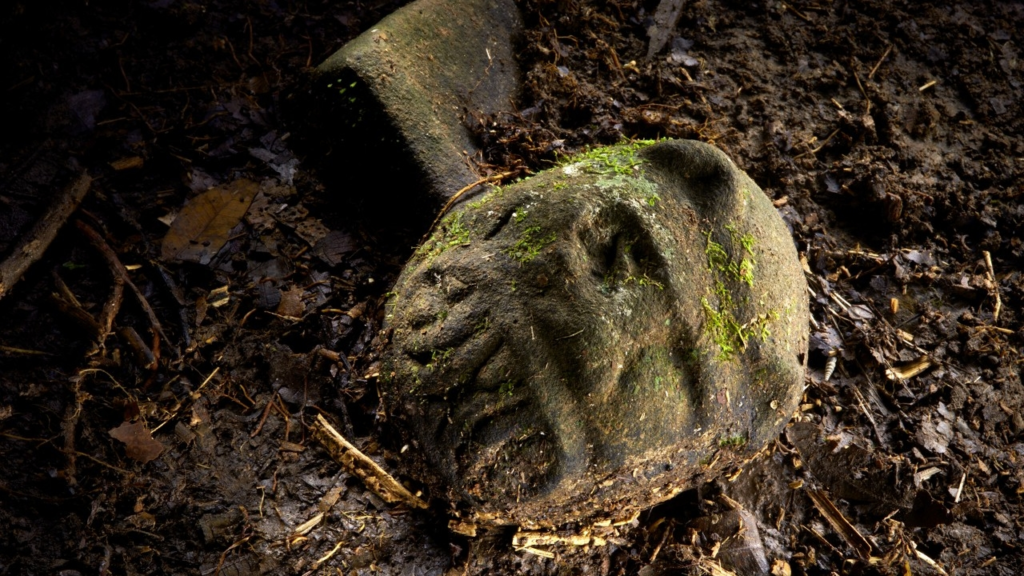

Adventurism, Neo-Colonial Exotic Treasure Hunting in Honduras
In my first month in Honduras years back, I met a Garifuna man in a small coastal village who in strict confidence brought me to his room to show me a monkey statue he had found in a remote site of the eastern Honduran rainforest called La Moskitia. The piece, not much bigger than his hand, was striking in its clean lines and very visible monkey shape in rounded pose. “Ciudad Blanca,” he said, “the great White City of the Maya.” Or, maybe not Maya, maybe another race of people, different from today’s indigenous residents, the Pech, the Tawahka.
Speed to March 2015, and the venerable National Geographic broke the exclusive: “Lost City Discovered in the Honduran Rain Forest.”
An expedition to Honduras…was led to the remote, uninhabited region by long-standing rumors that it was the site of a storied “White City,” also referred to in legend as the “City of the Monkey God.” Archaeologists surveyed and mapped extensive plazas, earthworks, mounds, and an earthen pyramid belonging to a culture that thrived a thousand years ago, and then vanished. — Douglas Preston, National Geographic
Let’s attempt to put aside his same publication’s recent forays into corporate-funded scientific obfuscation, and dissect this assertion about an uninhabited impenetrable jungle, where no archaeologist had yet dared to tread. Rosemary Joyce of UC Berkeley, expert on Honduran anthropology and archeology, weighed in:
Reading these reports, it seems like 1915 has come again and everything actual archaeologists have spent the last century learning has been swept away. For modern archaeologists who aren’t trying to aggrandize themselves or live a fantasy about tomb raiders, the imagery of “discovery” and “lost civilizations” make this story tragic: instead of knowledge, this story is a message of ignorance. — Rosemary Joyce, The Berkeley Blog
Honduran archaeologist Ricardo Agurcia wondered about this unknown team of explorers, whether what was found had any relation to the White City myth, and that multiple archeological sites are well known in La Moskitia. “In the legend of the White City (Ciudad Blanca) that I know there should be a monkey statue made of gold. If this is Ciudad Blanca, where is that monkey? I see a lot of tinges of adventure, of Hollywood films, as if from an Indiana Jones movie. That is not science,” pointed out Agurcia, a former Director of the Honduran Institute of Anthropology.
The issue was significant enough for a letter to be drafted, signed by 26 international scholars expressing serious concerns over the recent articles proclaiming the discovery of a lost city or lost civilization in Honduras.
STORY: Honduras: World Heritage Biosphere Trafficked Toward Destruction
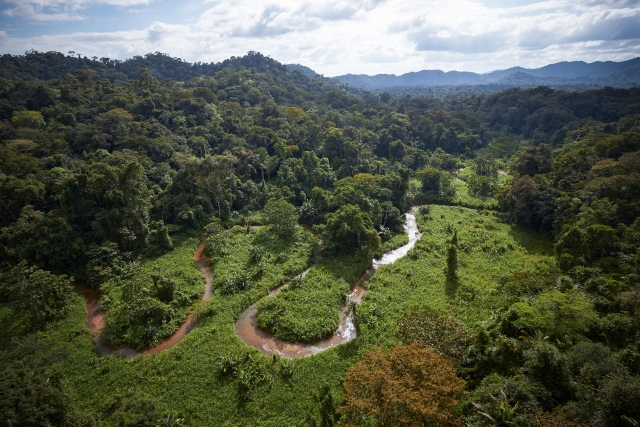

200 Identified Sites “Lost in the Jungle”
While this may be a newly identified site, Chris Begley, a Professor of Anthropology at Transylvania University, with a PhD from the University of Chicago, has engaged with over 200 others with related characteristics, including large sites with stone architecture and ballcourts documented in the existing archaeological literature, that cannot be verified without engagement with the broader, knowledgeable archaeological community. Dr. Begley said on the find, “The claim was never that these folks didn’t know about our previous research — we knew they did. But the area is promoted, in the recent articles, as unknown, and this archaeological culture as a new discovery. That’s just not accurate.”
Not quite uninhabited, the Pech, Tawahka, and Miskitu live in small villages mainly along the rivers, and have significant knowledge of these sites, as my coastal Garifuna friend attested to. These societies may be “vanished” from the eyes of the world because they largely live in the way of their ancestors far from cities, hunting, fishing and growing subsistence crops adjacent to the rivers. Again, Dr. Begley: “Who cares if you are the first or not? Not me. Who cares if local residents’ knowledge is ignored by the team of outsiders? A lot of us.”
Some of the multiple archaeological sites remain in “virgin jungle” and others already deforested in the departments of Olancho, Colon, and Gracias a Dios. Why do some sites get ignored by NatGeo, such as Dos Quebradas, documented almost 70 years ago, and large sites at Tayaco, and San Jorge de Olancho, which might not seem as otherworldly and jungle-covered to the foreign adventurer? Tourism promotion and the myth of the lost civilization?
The Pech already knew where every large site was located. Every single one. They knew where fruit trees grew, or where the good fishing holes were. They could find the little trails that I could hardly see. Sometimes we followed an old trail by looking for grown over machete cuts on branches. They knew the forest like I know my hometown. — Chris Begley
Do we follow the involvement of a corrupt dictatorship of Juan Orlando Hernandez known for crass promotion of free-trade cities and vast palm oil oligopolies? What about sending their new non-academic head of the Honduran Institute of Anthropology with a knack for marketing, backed by US-funded military force, to create a more fervent tourism impulse that might be a better draw than “Murder Capital of the World”? What will all the new cruise ship passengers at Trujillo, the resorts near Tela and Ceiba, and all the new ones to be built in the jungle do with their free time? How about, visit a “Lost City of the Monkeys in the Jungle”?
STORY: Free Trade Cities in Honduras: A Dangerous Experiment
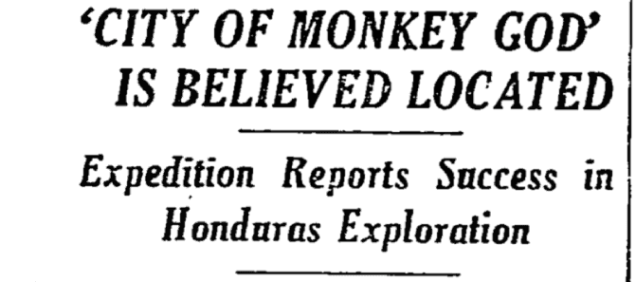
Legend of Ciudad Blanca
Local indigenous people told Conquistador Hernán Cortés, having plenty of reason to keep him moving on, of a civilization in Honduras where the nobles drank from golden cups. The story of Ciudad Blanca is, as Jason Colavito notes, one of exaggeration, wishful thinking, and the imposition of European cultural values onto Native landscapes.
In the nineteen-thirties, a number of expeditions began penetrating the Honduran interior, looking for the White City. George Heye, the son of an oil magnate, who founded the Museum of the American Indian in New York City, sponsored three of them. Nothing was discovered on the first two trips. Heye finally engaged Theodore Morde in 1939. The same author of the NatGeo piece, techno-thriller and horror novelist Douglas Preston, called him in The New Yorker a “swashbuckling American explorer.” It seems Mr. Morde located the White City, or colloquially, the Monkey God City. Unfortunately, the swashbuckler was run over by a bus in London before he could reveal its location to science.
The hype may well have originated as a real ruined city in the Honduran rainforest. Or, the whole thing could be a coincidence based on the fact that an actual civilization once existed where Natives tried to dupe Cortés into going, to get him out of their towns.
So, NatGeo, let’s not conflate myth and gringo aspiration with science. The residents of La Moskitia have kept the “civilized” world at bay for the last 500-some years. Give them some credit and respect, for once.



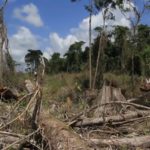
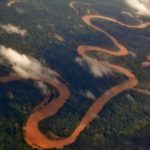
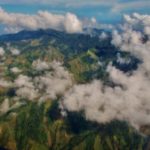
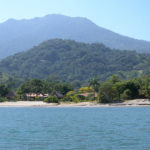
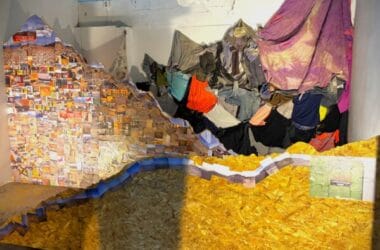
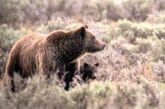




Charlie Frissell: What string of cheap shots at Nat Geo. The piece was never meant to do anything but, and what NG does, is call attention to something of interest to a general audience in hopes of advancing their goals of raising support for preservation,and investigation.
“This is clearly the most undisturbed rain forest in Central America,” said the expedition’s ethnobotanist, Mark Plotkin, who spent 30 years in Amazonia. “The importance of this place can’t be overestimated.”
“The region also is gravely threatened. Deforestation for ranching has checkerboarded the jungle to within a dozen miles of the valley. Huge swaths of virgin rain forest are being cut illegally and burned to make way for cattle. The region has become one of the biggest beef-producing areas in Central America, supplying meat to fast-food franchises in the United States”
…as far as Honduran Archaeologists Criticize US Claim of Archaeological “Discovery” ..Unfortunately, they continue to promote the idea that there was no previous research in the area;” they do no such thing, if 1 bothers to read the link to New Yorker piece it is clear they were looking at previous site survey maps.”He( had gathered the latest maps of all the known archaeological sites in Mosquitia; T1 was still a blank. “There’s no record of anybody ever being in T1,” he told me. “Even the expeditions in the nineteen-thirties and forties went around it, because it was too hard.” To be safe, Elkins chose three other areas to survey as well, which he called T2, T3, and T4. The first was a valley that was also rumored to contain the White City. The second was an area like T1—difficult to get to, seemingly unexplored. The second was an area like T1—difficult to get to, seemingly unexplored. The third had been visited in the nineteen-fifties by an American geologist, who claimed to have discovered the “crumbling limestone walls” of the White City, but recent satellite imagery revealed that the area had been laid waste by illegal logging, so it was dropped from consideration.”
As to your Dr Ricardo Argurcia link “so a less lazy”, would not include such ridiculious accusations as, “The publication by National Geographic that Ciudad Blanca has been discovered in the Honduran rainforest wakened unease and incredulity in experts in the country.”
In the NG piece, “It was indeed an ancient city. Archaeologists, however, no longer believe in the existence of a single “lost city,” or Ciudad Blanca, as described in the legends. They believe Mosquitia harbors many such “lost cities,” which taken together represent something far more important—a lost civilization.”
And as far as his seeming outrage, “Ricardo Agurcia, noted Honduran archaeologist, questions the possible discovery that would rise to a world-wide level because the investigation team that was formed, he says, is not well known, and nor does he know the institutions that participated and if there are Honduran experts involved.”Team member Oscar Neil Cruz, head archaeologist at the Honduran Institute of Anthropology and History (IHAH), believes the artifacts date to A.D. 1000 to 1400.”
I fully understand the issues at stake with preserving these rainforests and the archaeological sites there. That you have worked in the field is all the more reason you should understand the issue here. It is not a vanished culture, just an abandoned former settlement. It is not a city alone in the jungle undiscovered. It is a number of sites that are connected to many throughout the region that have been discovered, but not supported with money or help with the local people, nothing.
Maybe this can change with this sort of publicity, but their tomb-raider work so far has me nonplussed. The Monkey God and White City assertions are just hype, that is what I assert you are saying is okay. Sorry that you don’t see it that way. Mark Plotkin has credibility, but he’s attached himself to an expedition that is doing it wrong and that is what I am writing about. Haven’t we had enough of the colonist archaeologist who pretends with their superior technology they and only they have all the answers, and the people working there for years just get pushed aside?
Charlie Frissell: Money is a big problem, I worked on a coastal site in Ecuador, digging up the parking lot of a Chinese owned fish factory, horror story in itself, as they had no international health inspection certificate tons of grouper, red snapper, serra etc were pressed for the oil and the meal sold as pig feed to Europe, but I digress.
Part of the “lore” was of a giant emerald (golden monkey) that had been buried by locals at time of conquest to protect it (great story used to this day) Colombia’s Lake Guatavita and the Search for El Dorado,
It was rumored to be in the area, True or not made no difference in work being done or in conversation about the site. When there was money paid, 60 bucks a month. Vanished “cultures” are the norm, culture is not DNA…
Another thing I have a problem with is the story is being treated as a Guatavita like excavation when they only did a site survey, often done by just getting enough bodies that can walk and count in easier places. To say what the people involved did a”tomb-raider work” is not only insulting but very unfair, caption of photo: “Anna Cohen, a University of Washington anthropology grad student, documents a cache of more than 50 artifacts discovered in the jungle. Following scientific protocol, no objects were removed from the site. The scientists hope to mount an expedition soon to further document and excavate the site before it can be found by looters.”
What I think the intent of piece was, prime the begging for funds. Look forward to following what goes on but like many a tech start up, good luck but believe it when I see it.
Pingback: Colombia: Stunning Amazonian Prehistoric Rock Art | WilderUtopia.com
Pingback: Obama: Stop Funding Honduras' Corrupt President | WilderUtopia.com
Pingback: Honduras: World Heritage Biosphere Trafficked Toward Destruction